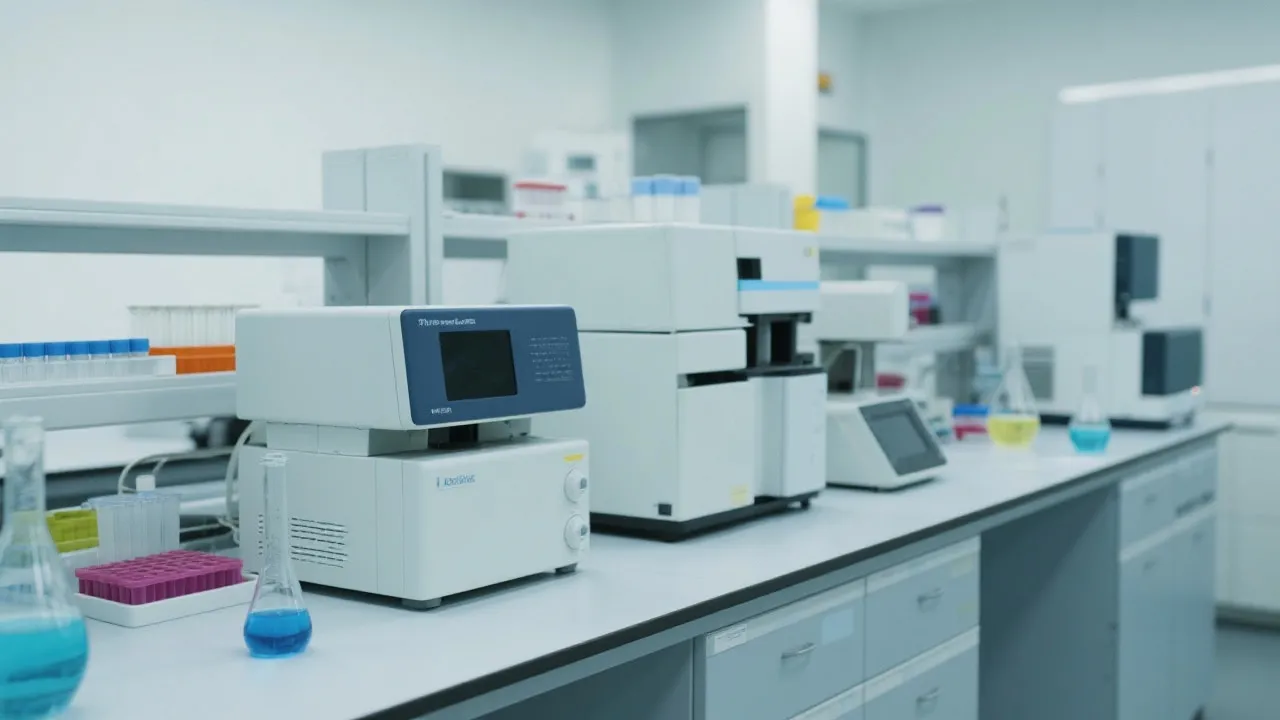Exploring the Role of Alox15 Inhibitors
Alox15 inhibitors are becoming a focus of attention in molecular biology for their potential in therapeutic applications. These inhibitors target the ALOX15 enzyme, playing a crucial role in managing inflammation and oxidative stress. The growing interest stems from their promise in treating conditions like cardiovascular diseases, cancer, and neurodegenerative disorders.

Understanding Alox15 Inhibitors
Alox15 inhibitors represent a fascinating area of research in the ongoing quest to develop therapies for various inflammatory and neurodegenerative diseases. The enzyme ALOX15 (arachidonate 15-lipoxygenase) is integral in the metabolism of arachidonic acid, leading to the production of bioactive lipid mediators. These mediators are implicated in inflammation and cell death, making the enzyme a key target in diseases where these processes are dysregulated. In this context, Alox15 is noteworthy not only due to its enzymatic function but also because of the broader implications its inhibition may hold for disease management.
Arachidonic acid itself is a polyunsaturated fatty acid that serves as a precursor for a wide array of eicosanoids, including prostaglandins and leukotrienes. The role of these bioactive lipids in cellular signaling is crucial, particularly in inflammatory responses. ALOX15 catalyzes the conversion of arachidonic acid into 15-hydroperoxyeicosatetraenoic acid (15-HPETE), which can further be metabolized into a host of other lipid mediators. This pathway underlines the significance of ALOX15 in physiological and pathological processes, highlighting the potential benefit of targeting this enzyme to modify disease outcomes.
The Significance of Alox15 in Disease Management
ALOX15's involvement in disease pathways primarily revolves around its role in inflammation and oxidative stress. This link is crucial because these processes are common denominators in many chronic conditions, including cardiovascular diseases, cancers, and neurodegenerative disorders like Alzheimer's disease. Indeed, the overactivity of ALOX15 has been associated with exacerbated inflammatory responses and increased levels of oxidative stress in tissues, leading to cellular damage and promoting disease progression. Thus, inhibiting ALOX15 has potential therapeutic benefits by reducing pathological inflammation and slowing disease progression.
In cardiovascular diseases, for instance, the role of ALOX15 has been highlighted in conditions such as atherosclerosis. The accumulation of oxidized low-density lipoprotein (oxLDL) in the arterial wall triggers inflammatory processes where ALOX15 may play a pivotal role. The enzyme's products contribute to the recruitment of inflammatory cells and the formation of foam cells, characteristic of atherosclerotic plaques. By targeting ALOX15, there is the potential to disrupt this vicious cycle, reducing plaque formation and ultimately the risk of heart attacks and strokes.
Furthermore, in oncology, the context of inflammation within tumors is critical. Tumors often manipulate inflammatory pathways to create a microenvironment conducive to growth and metastasis. For example, tumor-associated macrophages (TAMs) contribute to the establishment of an immunosuppressive environment, where ALOX15 is implicated in the production of pro-tumorigenic lipid mediators. Inhibiting ALOX15 may therefore provide a dual benefit: directly suppressing tumor growth and indirectly enhancing anti-tumor immunity.
In terms of neurodegenerative disorders, there is compelling evidence linking chronic inflammation with the pathophysiology of diseases such as Alzheimer's and multiple sclerosis. ALOX15 is implicated in the generation of neurotoxic lipid species that exacerbate neuroinflammation and neuronal death. Targeting this enzyme could potentially modify the course of these diseases by alleviating neuroinflammatory responses, thus protecting neuronal integrity.
Potential Applications of Alox15 Inhibitors
Research into Alox15 inhibitors is still in its early stages, but the preliminary outcomes look promising, indicating a wide array of potential applications:
- Cardiovascular Health: By mitigating oxidative stress and inflammatory responses, Alox15 inhibitors could help in reducing atherosclerosis and other heart diseases. The potential to diminish arterial inflammation and the progression of plaque formation positions these compounds as vital adjuncts to existing therapies in cardiovascular health.
- Oncology: In cancer therapy, these inhibitors might suppress tumor growth by disrupting the inflammatory environment that many tumors utilize for their advantage. Innovative drug formulations targeting ALOX15 activity may serve as novel adjuncts to conventional chemotherapies, aiming for improved clinical outcomes.
- Neuroprotection: Neurodegenerative diseases are characterized by chronic inflammation and oxidative damage. Alox15 inhibitors could potentially slow down or alter the course of diseases like Alzheimer's and Parkinson's. Such a strategy might not only benefit patients diagnosed with these conditions but also those at risk due to genetic or environmental factors.
- Chronic Respiratory Diseases: Given the role of ALOX15 in airway inflammation, particularly in asthma and chronic obstructive pulmonary disease (COPD), inhibitors may offer new therapeutic avenues for managing these conditions by targeting the inflammatory pathways involved.
- Metabolic Disorders: There is growing evidence to suggest that inflammation plays a role in metabolic syndrome, including diabetes and obesity. Alox15 inhibitors may provide a route to ameliorate associated inflammatory states, contributing to better metabolic health outcomes.
Challenges and Future Directions
While they hold promise, the development of Alox15 inhibitors must overcome several hurdles. Firstly, the specificity of inhibitors must be finely tuned to avoid unintentional modulation of other lipoxygenases, which could lead to adverse effects. The lipoxygenase family consists of several enzymes, including ALOX12 and ALOX5, each playing different roles in inflammatory processes. The cross-reactivity of inhibitors might lead to unanticipated consequences, making it critical to develop selective inhibitors that do not compromise the beneficial actions of other lipoxygenases.
Secondly, more comprehensive clinical trials are necessary to fully understand their efficacy and safety profile. Preliminary studies may show potential, but rigorous phase I to III clinical trials are essential to evaluate dose-response relationships, therapeutic windows, and long-term usage impacts. A robust clinical trial framework will also allow for identifying biomarkers that could predict patient responses to Alox15 inhibitors, thereby facilitating personalized treatment approaches.
Lastly, research should aim at integrating these inhibitors with existing treatment protocols to optimize patient outcomes. Combining Alox15 inhibitors with traditional anti-inflammatory agents or other therapeutic approaches could enhance efficacy while minimizing side effects. Such combination therapies may hold the key to unlocking synergies that improve disease management.
Integrating Alox15 Research in Clinical Settings
To efficiently bring Alox15 inhibitors from lab to clinic, an interdisciplinary approach that encompasses molecular biology, pharmacology, and clinical medicine is essential. Collaborative efforts could facilitate the translation of basic research findings into viable therapeutic strategies. For instance, partnerships between pharmaceutical companies and academic institutions could foster innovation in drug design and testing.
There is also a significant need for the establishment of biobanks to collect patient samples linked to ALOX15 activity. Analysis of these samples could reveal population-level data that would inform clinical use. Furthermore, engaging with regulatory bodies early in the development process can ensure that trials are designed to meet regulatory standards, thereby expediting the path to market.
In addition, educating healthcare providers about the potential of Alox15 inhibitors will be crucial for their successful integration into therapeutic regimens. Continued professional development and dissemination of research findings can bridge the gap between bench research and bedside applications.
Expert Insights and Commentary
Industry experts suggest that the next decade will be critical as researchers continue to unravel the complexities of ALOX15's role in various pathologies. The convergence of advances in genomic technologies and computational biology could accelerate the discovery of more potent and selective Alox15 inhibitors. Approaches such as CRISPR-Cas9 gene editing may be applied to create precise models for studying the effects of Alox15 inhibition, providing deeper insights into its biological functions.
Moreover, personalized medicine is increasingly at the forefront of modern therapeutic strategies, and the ability to profile ALOX15 activity in patients could lead to tailored therapies. This would not only enhance the efficacy of treatments with Alox15 inhibitors but also minimize potential side effects, promoting a patient-centric approach to therapy.
Frequently Asked Questions (FAQs)
- What are Alox15 inhibitors? Alox15 inhibitors are molecules that specifically inhibit the activity of the ALOX15 enzyme, reducing inflammation and oxidative stress.
- In which diseases could Alox15 inhibitors be beneficial? They show potential in treating cardiovascular diseases, certain cancers, neurodegenerative disorders, chronic respiratory diseases, and metabolic disorders.
- What challenges are associated with developing Alox15 inhibitors? Challenges include ensuring specificity, conducting thorough clinical trials, integrating with current treatments, and understanding the complex biological roles of ALOX15.
- How do Alox15 inhibitors work at a molecular level? Alox15 inhibitors block the enzymatic activity of ALOX15, thereby preventing the conversion of arachidonic acid into pro-inflammatory lipid mediators, reducing inflammation, and mitigating associated tissue damage.
- Are there any existing Alox15 inhibitors in clinical use? As of now, most Alox15 inhibitors are still in the investigational stage, with several candidates undergoing preclinical and clinical trials to evaluate their safety and effectiveness.
Conclusion
The exploration of Alox15 inhibitors forms a compelling chapter in the narrative of modern medicine. Research continues to reveal the multifaceted roles of ALOX15 in disease pathology, suggesting that targeting this enzyme may unlock new therapeutic avenues. As research progresses and regulatory pathways are navigated, these inhibitors might hold the key to unlocking new treatments and improving the quality of life for those suffering from chronic diseases. The future looks promising, with the potential for Alox15 inhibitors to emerge as a significant innovation in the treatment arsenal against a broad range of inflammatory and neurodegenerative diseases.
Furthermore, the ongoing advancement in technologies such as high-throughput screening and molecular modeling will likely yield new and more effective Alox15 inhibitors that can be precisely tailored to individual patient needs. With a concerted approach combining basic research, clinical application, and regulatory consideration, Alox15 inhibitors could become a staple in contemporary therapeutic interventions.
As the understanding of ALOX15's role in both health and disease expands, it is hoped that the next generations of therapeutics will lead to breakthroughs not only in symptom management but also in the overall prognosis of various chronic conditions. There lies a tremendous opportunity to shift the paradigm in how these diseases are approached, with a focus on modulation of inflammatory pathways through selective inhibition. This may ultimately set the stage for a new era in preventative and restorative medicine, aiming for lasting impacts on population health.





